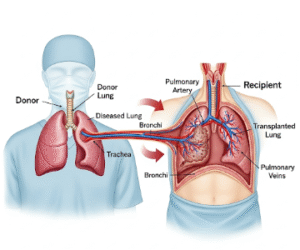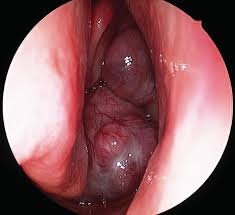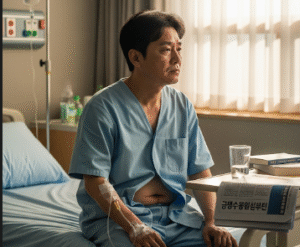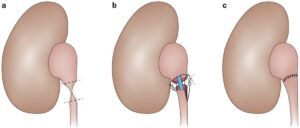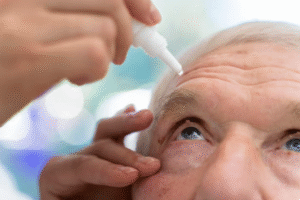➤ Overview
Shortness of breath, medically known as dyspnea, is the sensation of difficulty breathing or feeling unable to get enough air. It can range from mild discomfort during exertion to severe, life-threatening respiratory distress.
In South Korea, dyspnea is evaluated by pulmonologists, cardiologists, and emergency medicine specialists. Proper assessment is crucial to identify underlying causes, prevent complications, and provide timely treatment, particularly in acute or chronic conditions affecting the heart, lungs, or blood.
➤ Key Facts
→ Shortness of breath can be acute (sudden onset) or chronic (long-lasting).
→ Causes range from respiratory, cardiovascular, neurological, to systemic conditions.
→ Common in conditions like asthma, chronic obstructive pulmonary disease (COPD), heart failure, pneumonia, and anemia.
→ In Korea, chest X-rays, CT scans, blood tests, and pulmonary function tests are standard for evaluation.
→ Shortness of breath may occur at rest or only during physical activity.
→ Timely diagnosis improves treatment outcomes, reduces complications, and enhances quality of life.
→ Severe shortness of breath is a medical emergency requiring immediate attention.
➤ What is Shortness of Breath?
Shortness of breath is the subjective feeling of being unable to breathe comfortably, often accompanied by objective signs such as rapid breathing or use of accessory muscles:
→ Acute dyspnea – Sudden onset; may indicate heart attack, pulmonary embolism, or asthma attack.
→ Chronic dyspnea – Gradual onset; often linked to COPD, heart failure, or anemia.
→ Exertional dyspnea – Occurs with physical activity; common in heart or lung disease.
→ Orthopnea – Difficulty breathing when lying down; often associated with heart failure.
→ Paroxysmal nocturnal dyspnea – Sudden nighttime shortness of breath, waking the patient from sleep.
Korean specialists assess severity, duration, triggers, and associated symptoms to determine the underlying cause and guide treatment.
➤ What Symptoms are Related to Shortness of Breath?
Shortness of breath may present with a variety of associated symptoms depending on the underlying condition:
→ Rapid or shallow breathing (tachypnea).
→ Chest tightness or discomfort.
→ Cough – Productive or dry.
→ Wheezing – Especially in asthma or COPD.
→ Fatigue or exercise intolerance.
→ Bluish lips or fingertips (cyanosis) – Indicative of low oxygen levels.
→ Swelling in legs or ankles – Suggesting heart-related causes.
→ Dizziness or lightheadedness – Sometimes accompanying respiratory distress.
→ Palpitations or irregular heartbeat – Associated with cardiac causes.
➤ What Causes / Possible Causes?
Shortness of breath can result from respiratory, cardiovascular, neurological, or systemic conditions:
→ Asthma – Airways constrict, causing wheezing and dyspnea.
→ Chronic obstructive pulmonary disease (COPD) – Emphysema or chronic bronchitis leading to airflow limitation.
→ Pneumonia or lung infections – Inflammation and fluid accumulation in lungs.
→ Heart failure – Fluid buildup causing pulmonary congestion.
→ Pulmonary embolism – Blood clot obstructing pulmonary arteries.
→ Anemia – Reduced oxygen-carrying capacity of blood.
→ Obesity or deconditioning – Decreased respiratory efficiency.
→ Neuromuscular disorders – Weakness in muscles needed for breathing.
→ Allergic reactions or anaphylaxis – Swelling of airways and rapid onset dyspnea.
→ Anxiety or panic attacks – Hyperventilation can mimic shortness of breath.
➤ When Should I See My Doctor?
Immediate medical attention is required if shortness of breath is sudden, severe, or associated with danger signs:
→ Difficulty breathing at rest or inability to speak in full sentences.
→ Chest pain or pressure, possibly radiating to the arm, neck, or jaw.
→ Bluish lips, face, or fingertips – Indicating hypoxia.
→ Rapid heart rate, dizziness, or fainting.
→ Severe swelling in legs, ankles, or abdomen with dyspnea.
→ Acute onset after injury, surgery, or prolonged immobility (risk of pulmonary embolism).
→ Persistent or worsening shortness of breath despite initial treatment.
➤ Care and Treatment
Management depends on underlying cause, severity, and comorbid conditions:
→ Oxygen therapy – For hypoxia to maintain adequate blood oxygen levels.
→ Medications – Bronchodilators, corticosteroids, diuretics, or antibiotics depending on the cause.
→ Lifestyle modifications – Smoking cessation, weight management, and regular exercise for chronic conditions.
→ Pulmonary rehabilitation – Structured exercise and breathing techniques for chronic lung disease.
→ Emergency interventions – For acute asthma attacks, pulmonary embolism, or heart failure exacerbations.
→ Monitoring and follow-up – Regular assessment of lung and heart function.
→ Psychological support – Anxiety management for stress-induced dyspnea.
→ Surgical interventions – In selected cases, such as lung surgery or heart procedures.
➤ Treatment Options in Korea
South Korea provides comprehensive care for shortness of breath, combining advanced diagnostics, medical therapy, and rehabilitation programs:
Diagnosis in Korea
→ Pulmonary function tests – Evaluate airflow and lung capacity.
→ Chest X-ray and CT scans – Detect infections, structural abnormalities, or pulmonary embolism.
→ Echocardiography – Assess heart function and heart failure.
→ Blood tests – Detect anemia, infection, or metabolic imbalances.
→ Exercise or stress tests – Assess exertional dyspnea and cardiovascular fitness.
Medical Treatments in Korea
→ Bronchodilators and corticosteroids for asthma and COPD.
→ Diuretics and heart medications for heart failure.
→ Antibiotics or antivirals for respiratory infections.
→ Oxygen therapy for hypoxemia.
Advanced Therapies in Korea
→ Pulmonary rehabilitation programs – Breathing exercises, endurance training, and education.
→ Interventional procedures – Pulmonary embolism removal, stent placement, or heart surgery as indicated.
→ Multidisciplinary care – Pulmonology, cardiology, nutrition, and rehabilitation.
→ Integrative approaches – Korean traditional medicine for supportive symptom management.
Rehabilitation & Support in Korea
→ Guidance on daily activity adaptation and exercise tolerance.
→ Nutritional counseling to support energy and lung function.
→ Psychological support for stress, anxiety, or depression caused by chronic dyspnea.



